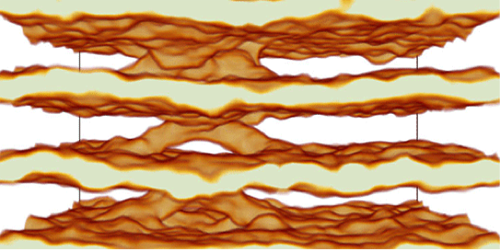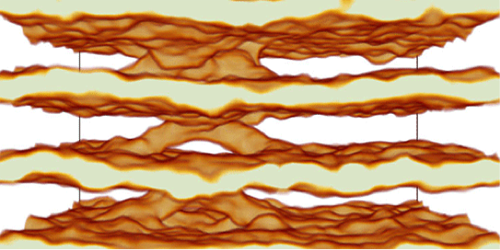Neutron Stars in a Petri Dish
Astrophysicists can only indirectly infer what’s inside of a collapsed supernova, or neutron star. But perhaps an analog system is just a microscope away. Theorists simulating the structure of a neutron star’s crust have identified features similar to those observed in cellular membranes. The finding suggests that although neutron stars and membranes differ by 14 orders of magnitude in their density, their structures may be determined by the same geometric constraints.
The outer layer of a neutron star is a dense blend of protons, neutrons, and electrons, in which long-range repulsive (Coulomb) forces compete with the shorter-range and attractive strong force. Simulations have shown that the balance of these forces causes matter to organize into dense regions separated by voids. These structures, termed “nuclear pasta” for their resemblance to shapes like lasagna and spaghetti, can influence a star’s heat loss and magnetic field.
Charles Horowitz of Indiana University, Bloomington, and colleagues previously predicted the lowest-energy pasta phase in dense nuclear matter using molecular dynamics simulations. By chance, Greg Huber, a biophysicist at the University of California, Santa Barbara, came across an article about the structures and recognized that one of them had a striking resemblance to the membrane folds in endoplasmic reticulum, a part of the cell involved in protein folding and transport. The researchers have now teamed up to study how this phase self-assembles out of uniformly distributed protons, neutrons, and electrons. Their simulations show that the particles organize into high-density filaments and then expand into layers connected by pairs of ramp-like junctions—similar to the floors of a parking garage. Having seen the same shapes in dense nuclear matter and biological membranes, the researchers speculate that the energies of both systems depend on their geometry in a simple, universal way.
This research is published in Physical Review C.
–Jessica Thomas
Jessica Thomas is the Editor of Physics.





